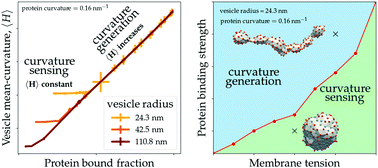Transition from curvature sensing to generation in a vesicle driven by protein binding strength and membrane tension
Abstract
The ability of proteins to sense and/or generate membrane curvature is crucial for many biological processes inside the cell. We introduce a model for the binding and unbinding of curvature inducing proteins on vesicles using Dynamic Triangulation Monte Carlo (DTMC) simulations. In our study, the interaction between membrane curvature and protein binding is characterised by the binding affinity parameter μ, which indicates the interaction strength. We demonstrate that both sensing and generation of curvature can be observed in the same system as a function of the protein binding affinity on the membrane. Our results show that at low μ values, proteins only sense membrane curvature, whereas at high μ values, they induce curvature. The transition between sensing and generation regimes is marked by a sharp change in the μ-dependence of the protein bound fraction. We present ways to quantitatively characterise these two regimes. We also observe that imposing tension on the membrane (through internal excess pressure for liposomes) extends the region of curvature sensing in the parameter space.



 Please wait while we load your content...
Please wait while we load your content...